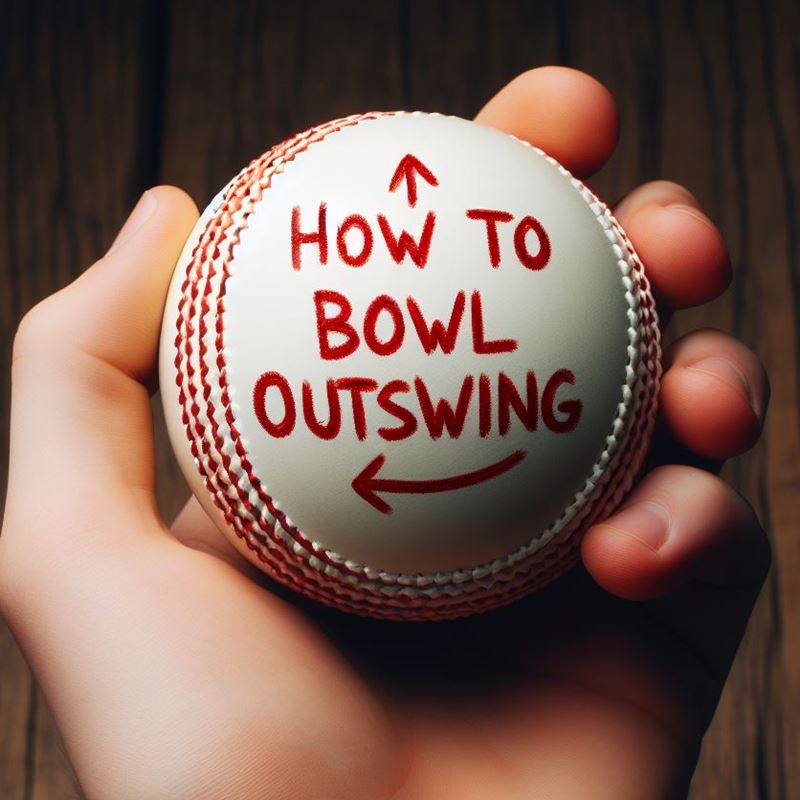In a previous post, we wrote about how to bowl an inswinger. In this post, we’ll now talk about how to bowl an outswinger.
Whether a ball is termed an outswinger, technically depends on the direction the ball swings related to the batter. If the bowl is swinging away from the batter, it is outswing; if it is swinging in to the batter, it is inswing.
However, the tips and techniques mentioned in this blog post relate to the delivery that swings from right to left for a right hand bowler, and from left to right for a left hand bowler.
Hopefully, we haven’t confused you so far.
The impact of an effective outswinger cannot be overstated. It adds a layer of complexity and challenge for the batter, compelling them to make a play outside their body line.
This increases the chances of edging the ball to the slip cordon or getting caught behind, making it a potent tool in dismissing top-order batsmen. Beyond its immediate threat in taking wickets, the outswinger significantly contributes to controlling the flow of runs, building pressure, and manipulating the batsman’s technique and footwork.
Like bowling an inswinger, bowling an outswinger is not just reliant upon seam position, wrist position and the such. These things are vital, but there are a number of external conditions that are completely out of a bowler’s control that can hinder or help outswing bowling.

Overcast Day – perfect for swing bowling
Optimal conditions for bowling an outswinger include overcast skies and a humid atmosphere, which help in enhancing the swing through the air.
Additionally, the type and condition of the pitch can influence the degree of swing a bowler can generate. A lush, green pitch is often more conducive to swing, whereas a dry, abrasive surface might not support as much lateral movement in the air but could assist in the ball’s seam movement upon bouncing.
Do I Need To Bowl Outswing?
It is probably prudent to say here that not all professional fast bowlers at international level can bowl swing, and most that do bowl swing, are either far more adapt at bowling one version than other, or can only swing the ball one way.
Most bowler’s natural delivery action will favour either seam (moving it off the pitch) or swing (moving it in the air). And those actions that do favour swing, will also naturally favour either inswing or offswing.
A bowler whose action natural favours inswing may have trouble bowling outswing, because they might need to adjust their action to compensate for the different wrist and arm position that outswing requires, and it is not natural to them.
The opposite is also true.
The point is, if your natural action favours inswing, or even seam bowling, don’t be too concerned if you struggle to bowl outswing. Try it out at the nets, but if feels too awkward, or it affects your pace too much, don’t worry about it.
Brett Lee rarely bowled inswing (except, perhaps, when the ball was reversing). His preference was away swing. And Glenn McGrath, while being capable of swinging the ball a little bit, rarely did so. He relied on unerring line and length.
And both of them ended up going alright.
But, if you do wish to learn more about outswing, and try to add that string to your bow, please continue to read on.
Basic Mechanics of an Outswinger
In our previous blog post about bowling an inswinger, we included a section called ‘The Science of the Inswinger: How Exactly Does A Ball Swing?’. We recommend having a read of that. While the section talks about ‘Inswing’, the science still remains the same, even if some of the specifics (i.e. the direction of the seam, and which side the shiny side is on) may need to be flipped.
And now that you’ve returned, we’ll talk about the basic mechanics of the outswinger.
Grip
The foundational aspect of any swing delivery, is how you grip the ball. The grip for bowling an outswinger is subtly nuanced but significantly impacts the ball’s trajectory.
You should hold the ball with the seam pointing towards slip or slightly gully, depending on the desired amount of swing. Your index and middle fingers should lie close together on the seam, with your thumb gently resting on the seam’s underside without exerting much pressure.
A second way to grip the ball is to initially put your index and middle finger close together on the seam, and then, without moving those fingers, adjust the seam of the ball underneath so that the seam points to 11am (1pm, if you’re a left hand bowler). This means that the tip of your middle finger is still on the middle of the seam, but your index and the rest of your middle finger is at a slight angle to the seam.
In both cases, gently rest your thumb on the seam’s underside, but don’t put too much pressure on the ball.
Arm and Wrist Position During Delivery
To bowl inswing, you arm had to be very high, near your ear, sometimes even a little beyond the perpendicular.
For outswing, you bowl with the arm a little further away from your ear. However, be careful, because if you bowl with your arm too far away from your head, keeping the seam upright when you release it becomes a lot more difficult.
Your wrist, at the point of delivery, should be angled towards 1st or 2nd slip. When you release the ball, your wrist should snap down behind the ball, causing the ball to spin backwards along its seam. The seam needs to stay upright, in order for the magic of science to work on the ball using the Magnus Effect.
The combination of a meticulously positioned grip and a precise arm and wrist alignment forms the mechanical core of an outswinger. These elements, when executed consistently, allow you to not only direct the ball accurately but also to manipulate its movement in the air, thus challenging even the most skilled batsmen.
Understanding and practicing these basics are essential for any bowler looking to add a reliable outswinger to their repertoire, making them a versatile and formidable opponent in the game of cricket.
Physical Conditioning and Drills
If you are looking to master the outswinger (or the inswinger), physical conditioning tailored to strengthen the specific muscles involved in swinging the ball is paramount. Effective training focuses on enhancing endurance, strength, and flexibility in key areas, ensuring that bowlers can maintain pace and precision throughout long spells.
Key Exercises to Develop Outswinger Muscles
Central to a bowler’s training regimen should be exercises that bolster your shoulders, core, and legs.

Overhead Press
Shoulder strength is crucial, as it supports the delivery and helps sustain the high arm position necessary for an effective outswinger. Exercises like overhead presses, lateral raises, and reverse flys build shoulder muscle resilience and power.
Strengthening the core is equally important; a strong core stabilizes the torso during the run-up and delivery, providing the foundation for a consistent bowling action. Planks, Russian twists, and leg raises should be integral parts of your fitness routine.
Lastly, leg exercises such as squats, lunges, and calf raises ensure that you have a strong base, crucial for both the run-up and the explosive action of bowling.
Wrist and Shoulder Drills
Specific drills that focus on the wrist and shoulder can significantly enhance your ability to swing the ball. For the wrist, exercises like wrist curls and extensions with light weights can improve flexibility and strength, critical for maintaining the correct wrist position at the point of release.
For shoulders, incorporating dynamic stretches and rotational exercises helps increase mobility and range of motion, which are vital for achieving the desired seam position and thus, the swing.
Incorporating these targeted exercises into regular training sessions not only builds the physical attributes necessary for bowling an outswinger but also helps in reducing the risk of injuries. Regular and disciplined practice of these drills ensures that you can execute outswingers with greater skill and consistency.
Common Mistakes and Troubleshooting
It doesn’t matter how experience a bowler you are, there’ll be times when your outswingers just won’t swing out any more. Identifying common pitfalls and knowing how to address them can greatly improve your effectiveness.
One of the most common mistakes with outswingers is incorrect seam position at the point of release. If the seam is not upright and tilted slightly towards the slips, the ball may not swing effectively, reducing its potential to deceive the batsman.
Another frequent error is inconsistent run-up and delivery stride, which can disrupt your rhythm and balance, leading to poor execution of the ball’s intended line and length.
Bowlers also sometimes struggle with overstraining, trying to generate excessive swing. This often results in losing control over the ball’s direction, making it too wide or too full, easy for batsmen to leave or hit confidently. Maintaining a relaxed yet firm wrist and arm speed is crucial to avoid this.
Tips to Correct Your Outswinger Technique
To correct seam position issues, try practicing holding the ball with the seam angled towards first or second slip and focus on releasing the ball with the wrist held back firmly. This position should be reinforced through repetitive practice to ensure it becomes second nature during the game.
Improving the consistency of the run-up and delivery stride can be achieved by marking the run-up and practicing it repeatedly to ensure that each delivery starts and ends the same way. Video analysis can be extremely helpful in identifying and correcting deviations in the run-up and action.

If you think you are trying too hard to swing the ball, the key is to focus on maintaining a smooth and natural bowling action. Reducing the effort in trying to swing the ball and allowing the grip, seam position, and natural wrist action to do the work can lead to more effective and controlled swing.
Regular drills focusing on these aspects, combined with video feedback and possibly coaching advice, can significantly improve your ability to deliver precise and challenging outswingers. This not only enhances your skill set but can also boost your confidence in using the outswinger as a strategic weapon in matches.
Just remember that you are not in control of every facet that is required for successful outswing. The reason you might not be swinging the ball much at the moment could be because the weather is not humid enough, the pitch is too dry, or the ball is too roughed up, and even that the ball itself is not conducive to great swing.
Great line and great length, with a little variation in your deliveries here and there, will take you a long way, particularly in the longer form of the game.
Advanced Techniques and Variations
Once the fundamental aspects of bowling an outswinger are mastered, you can explore advanced techniques and variations that enhance the delivery’s effectiveness. This progression involves sophisticated strategies that can confound even the most skilled batter, making the outswinger a more lethal and versatile tool in a bowler’s repertoire.
Advanced outswinger tactics often involve manipulating the batter’s expectations. One effective strategy is to alter the point of release subtly. By releasing the ball slightly earlier or later than usual, you can change the angle at which the ball arrives at the batter, thus affecting its swing and the timing of the batter’s shot.
Another advanced technique is to vary the degree of seam position actively during an over to create uncertainty about the swing’s direction and magnitude. Sometimes, a straight ball can do as much damage as a swinging ball, if the batter isn’t expecting it.
Additionally, combining the outswinger with a well-executed slower ball can be particularly deceptive. This variation requires perfecting the ability to maintain the same arm speed while releasing the ball slower, which can cause the batter to play too early and potentially get caught out.
Other things you can think of: bowl from different places on the bowling crease. Bowl some deliveries close to the stumps, and for others go wider. Some of these new angles can make the outswinger seem more pronounced.
Last Word On Outswingers
If you struggle bowling outswing, consider whether or not you really need it in your repertoire. Don’t bowl it just because your favourite bowler does, or you read online that bowling outswing is a must. The delivery should still feel natural to you, and you should be able to bowl it with as close to your normal action as possible, otherwise it will be too easy for the batter to pick up on the variation and attack it
Also, don’t worry if you can’t get the bowl to hoop around corners. Glenn McGrath once said that if you swing the ball, you only need to swing it half the width of the bat … so that a ball that would have hit the middle now hits the edge, and goes to slip. Madly swinging deliveries look cool, but if they keep missing the bat or stumps, it doesn’t do you any good in the wicket column.
I hope you enjoyed this post. We’ll talk soon on what reverse swing is, and how to bowl it. In the meantime, if you have any questions or you want to talk about your favourite outswing bowler, leave your comments in the comment box below.

